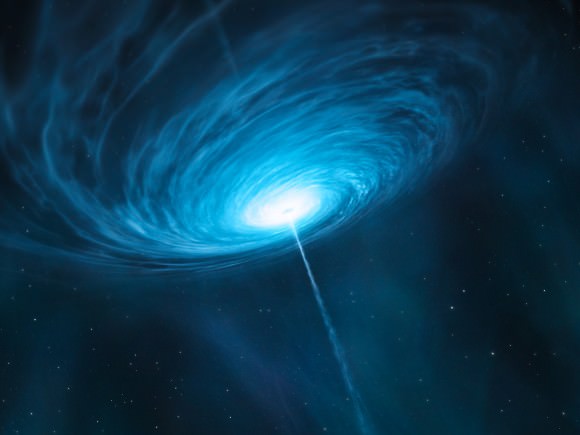The spin rate of the most distant supermassive black hole has been measured directly, and wow, is it fast. X-ray observations of RX J1131-1231 (RX J1131 for short) show it is whizzing around at almost half the speed of light. Through X-rays, the astronomers were able to peer at the rate of debris fall into the singularity, yielding the speed measurement.
“We estimate that the X-rays are coming from a region in the disk located only about three times the radius of the event horizon — the point of no return for infalling matter,” stated Jon Miller, an an associate professor of astronomy at the University of Michigan and a co-author on the paper. “The black hole must be spinning extremely rapidly to allow a disk to survive at such a small radius.”
Supermassive black holes are embedded in the heart of most galaxies, and are millions or even billions of times for massive than the Sun. This makes the spin speed astonishingly fast, but also gives astronomers clues about how the host galaxy evolved.
“The growth history of a supermassive black hole is encoded in its spin, so studies of spin versus time can allow us study the co-evolution of black holes and their host galaxies,” stated Mark Reynolds, an assistant research scientist in astronomy at University of Michigan, another co-author on the study.

RX J1131 is six billion light-years away from Earth and classified as a quasar, a type of object that occurs when a lot of matter plunges into a supermassive black hole.
“Under normal circumstances, this faraway quasar would be too faint to study. But the researchers were able to take advantage of a sort of natural telescope effect known as gravitational lensing and a lucky alignment of the quasar and a giant elliptical galaxy to get a closer view,” the University of Michigan stated.
“Gravitational lensing, first predicted by Einstein, occurs when the gravity of massive objects acts as a lens to bend, distort and magnify the light from more distant objects as it passes.”
In this case, the researchers used the Chandra X-ray Observatory and the European Space Agency’s XMM-Newton Telescope to capture the X-ray images.
The research was led Rubens Reis, a postdoctoral research fellow in astronomy the University of Michigan. The paper is published today (March 5) in Nature.
For further reading, see the Chandra website and the associated NASA press release.
Source: University of Michigan


A spin rate equated to a speed? Ouch, that hurt.
yes, how many revolutions/min (or second) is that?
Presumably that’s the circumferential speed of the accretion disk that is producing the X-rays. If the radius were known, the angular velocity (of the accretion disk) would be easy to calculate, but perhaps they don’t know it. The angular velocity would increase as you get closer to the center, but that calculation is complicated by relativistic effects.
If we know the spin rate and mass how come we can’t tell how large the mass at the center of the hole is?
Question: if they know spinrate and know circumverence speed being 0.5 speed of light … does this mean they finally know the size of a blackhole hidden within the Swarzshild radius?
Or did you mean to say the accretion disc at ~3 x Swarzshild radius has a speed of about 0.5 the speed of light?
By carefully studying and modelling the gravitational lens, scientists can use this knowledge to reconstruct the appearance of the (unlensed) source. A 2006 study provided this reconstructed image of the lensed quasar/Seyfert I galaxy in RX J1131-1231: http://inspirehep.net/record/787214/files/1131_source.png
Details of how this image reconstruction was achieved can be found here: http://www.aanda.org/articles/aa/full/2006/21/aa4352-05/aa4352-05.html
(In particular Fig 6 in the paper details the correspondence of features in the lensed system with the reconstucted image)
Thanks! =)